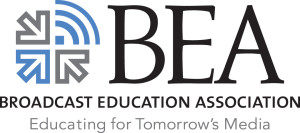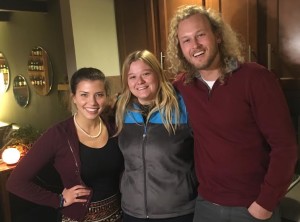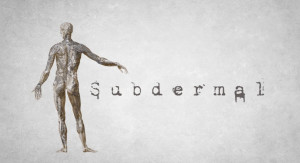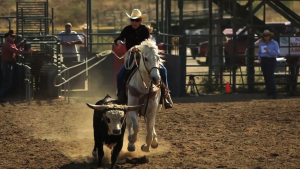Nine CSU students and an instructor from the Department of Journalism and Media Communication earned national awards from the Broadcast Education Association’s (BEA) Festival of Media Arts.
 Awards include Best of Festival and Honorable Mention in the student documentary production category, an Award of Excellence in the long-form documentary category for faculty, and awards for client videos, television feature reporting and audio production.
Awards include Best of Festival and Honorable Mention in the student documentary production category, an Award of Excellence in the long-form documentary category for faculty, and awards for client videos, television feature reporting and audio production.
The Broadcast Education Association was established in 1955, and is a national academic organization focused on research and teaching in media arts. More than 2,500 students, professors and media professionals are individual members, and about 275 university departments or schools, including CSU’s Journalism and Media Communication Department, are institutional members.
Largest of its kind
The organization’s Festival of Media Arts is the largest competition for faculty and student TV productions and documentaries. The 2015 competition included more than 1,500 entries, which were judged by professionals and faculty members from across the country.
Steven Weiss, a JMC faculty member and award winner, is one of scores of faculty members who help judge productions for the BEA. He said that the judging committee meets annually to discuss judging categories, and that production quality and the overall storytelling skills of the film are the main qualifications. Judges who are associated with a university do not evaluate any content submitted by that institution.
The two student documentary winners were class projects for the Documentary and Video Production course taught by JMC Department Chair Greg Luft. For this assignment, students are required to select a topic that is approved by classmates and the instructor, and interview at least 10 sources. The project must be 15-20 minutes long, and include a history section. It has to be completed in one semester.
Best of Festival: Bean to Bar
The documentary Bean to Bar: Chocolate Unwrapped follows Old Town chocolate shop Nuance Chocolate to shed light on ethical practices, collaboration efforts and the processes that go into making homemade chocolate.

Weston Dockter, Elizabeth Ruiz and Megan Rakoczy used their production, videography and editing skills to create a project that gives a behind-the-scenes look at the mom-and-pop shop.
Nuance Chocolate makes all of its products from scratch, and they are “made straight from beans roasted and ground in Old Town Fort Collins,” according to its website.
Toby Gadd, the shop’s co-founder, is featured in the film and talks about how large-scale chocolate making is often an exploitative industry. He explained that the purpose of their local shop is to demonstrate to consumers the importance of buying ethically produced products.
Dockter, Ruiz and Rakoczy consider themselves a “great team” and combined all of their different skills and strengths while working on production.
Upon finding out that their film won an award, the team said that they were all in disbelief. Out of more than 1,500 productions submitted in a wide variety of categories for the competition, only 18 earn best of festival distinction. Bean to Bar was the top entry for all student documentaries.
The students said winning the competition only reaffirmed their choice of the JMC degree path. When asked about how the BEA experience has affected their interests, Megan wrote in an email, “I’ve had a passion for it since I was a little kid, and this award has just been a confidence booster and confirmed for me that I am in the right field.”
The team is brainstorming future project ideas and efforts for WideEyed Productions.
Honorable Mention: Subdermal
Alex Huff, Ben Ward and Will Baker’s film Subdermal highlights the history of tattoos, what they mean for the people who have them, and some of their impacts, from an employer’s perspective. The film features three tattooed individuals, two tattoo artists and a professor from the College of Business. 
The documentary opens by showing artistic variety across tattoos and discusses how tattoos can be considered just another form of personal expression. JMC senior Ben Ward talked about how his group found some of the people who were featured in Subdermal.
“We posted on Facebook that if you have tattoos, come down to Clark A 70 for a free donut,” Ward said.
Several tattooed individuals showed up, and the student team used the volunteers for a “dubsteppy-montage” opening scene. The main subjects for the film were friends of the Subdermal group. Each individual brings a unique story and perspective on the art form to the documentary.
Much like the other productions, the team put in countless hours of editing, filming and producing to perfect their work.
“We did a bulk of editing the weekend before it was due,” Ward said of the editing process. “It was like a 24-hour editing marathon.”
The musical selection, scene changes, camera angles and graphics were tastefully chosen in a way that creates a cohesive theme and vibe for the documentary.
“I’m thankful for the resources that the journalism department has given us to make things like this possible,” Ward added.
Award of Excellence: Hollywood’s Last Real Cowboy
Instructor Steve Weiss’ Hollywood’s Last Real Cowboy follows cowboy and Hollywood stuntman Gene McLaughlin to spotlight the traditional Western rodeo and cowboy lifestyle. Weiss was one of two faculty members who were recognized in the long-form documentary category, which Greg Luft, JMC department chair, describes as “one of the most competitive competitions in the festival.”

“Like most good stories, it [the topic] came from a friend of a friend,” Weiss said when asked about the source of inspiration for the film.
McLaughlin is a true American cowboy in every sense of the phrase. He is known for his trick roping skills, has participated in countless rodeos, has been a stuntman, has starred in Hollywood films next to John Travolta and other major actors, and still runs his own family ranch in California.
The 58-minute documentary highlights how McLaughlin was interested in the industry from a young age and how he eventually found success out West. Weiss followed McLaughlin for over a year, meaning several trips out to California.
“We became really good friends because of this,” Weiss said.
Hollywood’s Last Real Cowboy is the first draft of a documentary that Weiss has sent to the History Channel, Discovery Channel, Bio, PBS and a few other networks in hopes of securing an airing to bring the story to a national television audience.
“I’m grateful for the support of Greg Luft … and the college,” Weiss said. “Prior to [working at CSU], there was no time for producers working on corporate videos to do this type of project.”
Weiss also said he is very proud that the BEA awards shed positive light on the journalism department at CSU.
“It’s a talented bunch of students we have here,” he said.
Other festival winners
In addition to winners in the documentary category, several other CSU students earned awards for other types of productions.
Eli Portell earned two awards in the client video competition – one for a commercial about The Summit Windsor Recreational Center, and another for a promotional spot about CSU research. Kay Bennet earned an award in television feature reporting for a Collegian Television (CTV) story on American sign language, and KCSU staff member Laurelle Turner earned an audio production award for a KCSU music history program.
Links to the films
While all of the films have a very different take on documentary making, they exhibit the artistic talent and videography skills of the award winners and show the impact and exposure that films like these are intended to have. Below are links to the films:
Bean to Bar: Chocolate Unwrapped